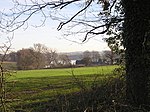Shepshed Cutting
ShepshedSites of Special Scientific Interest in Leicestershire

Shepshed Cutting is a 6.0 hectares (15 acres) geological Site of Special Scientific Interest west of Shepshed in Leicestershire.The Triassic deposits in Shepshed Cutting are unique, with a flat sheet of galena resting on red clay, and the whole enclosed in sandstone. The site is described by Natural England as "of international importance for developing a better understanding of the origins of mineral deposits and the processes which form them".A public footpath runs through the site.
Excerpt from the Wikipedia article Shepshed Cutting (License: CC BY-SA 3.0, Authors, Images).Shepshed Cutting
Jubilee Path, Charnwood Shepshed
Geographical coordinates (GPS) Address Nearby Places Show on map
Geographical coordinates (GPS)
| Latitude | Longitude |
|---|---|
| N 52.762 ° | E -1.319 ° |
Address
Jubilee Path
Jubilee Path
LE12 9NE Charnwood, Shepshed
England, United Kingdom
Open on Google Maps








